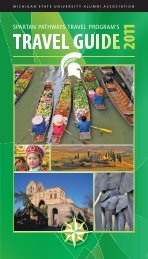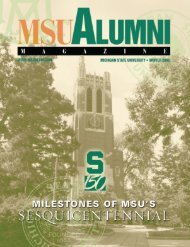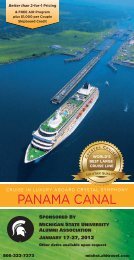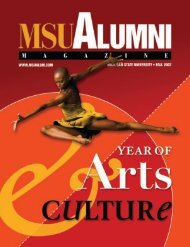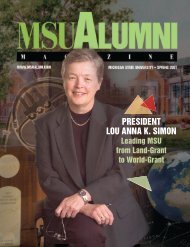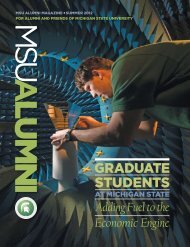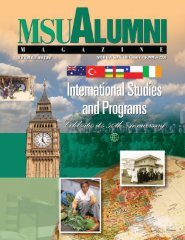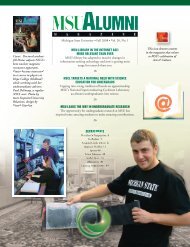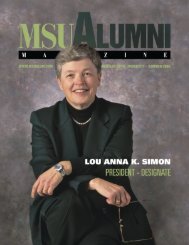mark dantonio - MSU Alumni Association - Michigan State University
mark dantonio - MSU Alumni Association - Michigan State University
mark dantonio - MSU Alumni Association - Michigan State University
Create successful ePaper yourself
Turn your PDF publications into a flip-book with our unique Google optimized e-Paper software.
sor of chemistry, and colleagues<br />
Daniel Jones and Gavin Reid.<br />
“This kind of science that I’m<br />
working on—we call it smart<br />
laser technology—is using properties<br />
of lasers that have not been<br />
exploited before,” says Dantus.<br />
“It’s also a special type of laser<br />
with a tremendous number of<br />
applications.”<br />
These smart lasers could lead to<br />
new, safer drugs, since scientists<br />
can now study side effects at the<br />
molecular level with more precision.<br />
Scientists can also use them<br />
to analyze blood more precisely.<br />
In the hands of homeland security<br />
agents, it can help detect chemical,<br />
biological and explosive agents.<br />
The Dantus team earned $1.4<br />
million through the state’s 21st<br />
Century Jobs Fund for further<br />
research and development. Dantus’<br />
company, BioPhotonic Solutions, is<br />
one of two SmartZone businesses<br />
created in downtown East Lansing.<br />
BLACK HOLE IN CLUSTER<br />
One mystery of black holes that<br />
has confounded generations of<br />
astronomers has now been solved<br />
by <strong>MSU</strong> astronomer Stephen<br />
Zepf and an international team<br />
of astronomers.<br />
As published online in Nature<br />
(Jan. 3, 2007), Zepf and his colleagues<br />
have been able to finally<br />
confirm the existence of a black<br />
hole within a globular cluster.<br />
A black hole occurs when a<br />
large star dies, collapsing into<br />
itself and creating a gravitational<br />
field so strong that light cannot<br />
escape from it. A globular cluster<br />
is a dense group of stars. Some<br />
astronomers had questioned<br />
whether a black hole could exist<br />
within such a dense environment.<br />
Zepf and his colleagues were<br />
able to detect the X-ray emissions<br />
of a blackhole in a globular cluster<br />
known as NGC 4472. “Our timing<br />
was somewhat fortuitous,” says<br />
Zepf. “This was only the second<br />
globular cluster we looked at.”<br />
HOW TO READ “INVISIBLE INK”<br />
The Stasi, the notorious East<br />
Germany secret police, were<br />
known to use a sophisticated<br />
invisible ink for their espionage.<br />
The ink’s formula had been a<br />
secret, until now.<br />
Two professors with <strong>MSU</strong>’s<br />
Lyman Briggs School of Science—science<br />
historian Kristie<br />
Macrakis and chemist Ryan<br />
Sweeder—with the help of two<br />
undergraduate researchers, have<br />
figured out the invisible ink’s<br />
chemical composition.<br />
After the fall of the Berlin wall in<br />
1989, the Stasi had left behind an<br />
incomplete formula for the invisible<br />
ink, which Macrakis stumbled onto<br />
when studying the once-confidential<br />
Stasi archives. She and Sweeder<br />
set out to complete the formula in<br />
their so-called “Spy Lab,” and eventually<br />
succeeded.<br />
The Stasi encoded invisible ink<br />
messages by writing with cerium<br />
oxalate, which would then be<br />
made visible—in orange—by<br />
applying a solution of manganese<br />
sulfate, hydrogen peroxide and<br />
other chemicals.<br />
POSSIBLE HELP FOR STROKE<br />
<strong>MSU</strong> researchers have found a<br />
possibly superior way to reduce<br />
the severity of a stroke.<br />
Photo courtesy of the <strong>MSU</strong> Museum<br />
MUST SEE MUSEUM—Last fall,<br />
USA Today named the <strong>MSU</strong> Museum<br />
as one of “10 Great Places To<br />
Be Enveloped In Quilts.” The paper<br />
noted the Museum’s collection<br />
of more than 35 quilts by black<br />
<strong>Michigan</strong>ians, discovered in the<br />
mid-1980s, and highlighted Beverly<br />
Ann White’s Mr. Mandela portrait quilt (seen here). The <strong>MSU</strong><br />
Museum is home to the Great Lakes Quilt Center, with a collection<br />
of more than 500 historic and contemporary textiles, research and<br />
archival documents. “Redwork: A Textile Tradition in America” is<br />
on exhibit in the <strong>MSU</strong> Museum’s Heritage Gallery through October<br />
2007, tracing the origins and popularization of a striking red-on-white<br />
needlework technique first seen in the 1880s and still produced today.<br />
☛ For more information, call (517) 432-3800 or visit<br />
www.museum.msu.edu/glqc.<br />
Arshad Majid, associate professor<br />
of neurology and ophthalmology,<br />
and colleagues have found<br />
that the dietary supplement<br />
carnosine—a common product<br />
available over-the-counter—consistently<br />
reduced the severity of<br />
stroke by up to 50 percent in<br />
laboratory mice.<br />
“That’s huge,” says Majid. “At<br />
first, I didn’t believe the results,<br />
so we repeated the test many<br />
times. These are very promising<br />
results. If you can reduce<br />
the size of the stroke by half,<br />
that means less disability for the<br />
patient.”<br />
The researchers also found<br />
that use of carnosine was still<br />
effective after the onset of stroke<br />
symptoms. Majid notes that<br />
carnosine is nontoxic, whereas<br />
current stroke medications can<br />
be dangerous.<br />
HAND-HELD DEVICE TESTS<br />
PATHOGENS<br />
<strong>MSU</strong> researchers are developing<br />
a hand-held device that can<br />
test for deadly food, air and water<br />
pathogens.<br />
Syed Hashsham, associate professor<br />
of civil and environmental<br />
engineering at the Center for<br />
Microbial Ecology (CME), is<br />
developing a portable device that<br />
can detect up to 50 microbial<br />
threat agents.<br />
“This device will give us the<br />
ability to measure pathogens in a<br />
manner and at a price that really<br />
matters for human health,” says<br />
Hashsham.<br />
Currently testing for pathogens<br />
like cholera and dysentery<br />
must be done one pathogen at<br />
a time. The device is capable<br />
of simultaneous testing, thus<br />
simplifying the process and increasing<br />
the cost-effectiveness.<br />
Hashsham has been awarded<br />
$966,608 from the 21st Century<br />
Jobs Fund to develop and commercialize<br />
the device. His team<br />
includes James Tiedje, <strong>University</strong><br />
Distinguished Professor of crop<br />
and soil sciences and director of<br />
the CME.<br />
EVENING COLLEGE EXPANDS WEST<br />
<strong>MSU</strong>’s Evening College, which<br />
has provided noncredit personal<br />
enrichment for alumni since 1951,<br />
has expanded into<br />
Grand Rapids.<br />
Beginning in<br />
Spring 2007, several<br />
courses will be held<br />
in the Kent County<br />
Extension Building<br />
in Grand Rapids.<br />
This move was<br />
made in concert<br />
with <strong>MSU</strong> Extension,<br />
Central<br />
Region, and the<br />
West <strong>Michigan</strong><br />
alumni regional club, notes Louise<br />
Cooley, director of Evening<br />
College and assistant director of<br />
the <strong>MSU</strong> <strong>Alumni</strong> <strong>Association</strong>.<br />
“We’re offering five classes,<br />
ranging from information strategies<br />
to European travel and<br />
medieval art books,” says Cooley.<br />
“This expansion allows us to<br />
serve a much larger constituency.”<br />
Evening College is offered by<br />
<strong>Alumni</strong> Lifelong Education, a<br />
component of the <strong>MSU</strong> <strong>Alumni</strong><br />
<strong>Association</strong>. Those wishing<br />
Click Right Through for <strong>MSU</strong><br />
www.msualum.com<br />
Page 7<br />
046957070001_04-9.indd 7<br />
2/2/07 1:03:46 PM




